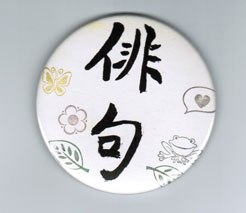May 2020 – I’ve been trying to teach myself how to write haiku (as well as senryu, but for simplicity’s sake I use the term haiku to refer to them both) for about five years now, so let’s get one thing clear right from the top. I have no idea if my haiku are any good. Furthermore, I don’t really care. I write them for my own pleasure. If some of them turn out to be good, fine. If not, that’s fine too. They are what they are.
This is not to say I am interested in writing bad haiku. I would like them to be good, or at least adequate. But after some back and forth with myself, I’ve come to realize that striving to be a good haiku writer is probably just as useless as striving for any goal. I refer to a quote from Lin-Chi:
“In Zen there is no place for using efforts. Just be ordinary and nothing special. Eat your food, move your bowels, pass water, and when you’re tired go and lie down.”
So, if a haiku comes to me, I spend some time considering it, and write it down when I think it feels right.
As in any form of writing, style is always a consideration. I consider my style to be an “ordinary” style. I like my haiku to be plain, unadorned, and easy to understand and grasp. I don’t sit down to write a haiku every day. I do not strive much for sophistication and polish. I do look for what I consider to be “haiku moments,” moments that contain something of the eternal, of the Tao, in the present moment I happen to be in. Often for me, what happens is this: I am seeing or experiencing something, and as I see or experience it, a haiku may start to form. If it does, I see where the flow leads. I might take notes, either mental, written, or via an audio recording. I may shape it later when the moment comes to set it down as a written haiku. That’s about it.
In his essay “Square Zen, Beat Zen, and Zen” (1958), the writer Alan Watts discusses art in the context of Zen. He writes that art that has a true Zen spirit is one in which a “controlled accident” has taken place. In the case of haiku, the “controlled accident” to me is when an experience or moment accidentally, or spontaneously, collides with language. It produces what Watts refers to as li, or “organic pattern.” The power of an artist to harness li with continuing success is called te, translated as “magical virtue.” The more te an artist can harness and possess, the more they can harness the li present in these “controlled accidents.” The difficulty is that the artist can never quite explain how this happens; it just happens. As Watts explains:
The artist has to know it as he knows how to grow his own hair. He can do it again and again, but can never explain how.
When I was teaching acting, I taught as a basis for all good acting the art of improvisation. Improv is often subjected to much ridicule (much like 5-7-5 haiku; see below), but when taught and executed correctly it is the best technique from which to build a foundation of powerful, fresh, and believable acting, for it teaches the actor how to live, breathe, and respond within and to the present moment they may find themselves within a performance. As a haiku writer, this is what I am attempting to embrace, transforming my training, skills and talent as an actor into writing haiku as “controlled accidents,” and embracing whatever te I may possess to write good ones.
 I support the writing of 5-7-5 haiku, and have written more about that here. I embrace the challenge of form as well as essence. I understand completely that 5-7-5 English haiku is a slight misrepresentation of the Japanese sense of 17 on, but I think it matters not. Given that there is no precise, exact match, I see nothing wrong in composing a 5-7-5 haiku in English any more than I would consider writing a 14-line sonnet to be “wrong” when compared to a free-verse poem. The problem is not that 5-7-5 English haiku is wrong; it’s that there is a very shallow understanding in the general culture of the 5-7-5 form itself. Too many people write ill-informed “haiku” because they believe the number of syllables is all that matters. I still very much try to subscribe to the notions of juxtaposition of concepts or images, a seasonal flavor or reference, and nature as a predominant subject matter. The fact that these ideas can be contained within the 5-7-5 form is, to me, a separate challenge involving form and style. Still, I also enjoy writing tighter haiku with less syllables when I can and when I feel the particular haiku calls for it.
I support the writing of 5-7-5 haiku, and have written more about that here. I embrace the challenge of form as well as essence. I understand completely that 5-7-5 English haiku is a slight misrepresentation of the Japanese sense of 17 on, but I think it matters not. Given that there is no precise, exact match, I see nothing wrong in composing a 5-7-5 haiku in English any more than I would consider writing a 14-line sonnet to be “wrong” when compared to a free-verse poem. The problem is not that 5-7-5 English haiku is wrong; it’s that there is a very shallow understanding in the general culture of the 5-7-5 form itself. Too many people write ill-informed “haiku” because they believe the number of syllables is all that matters. I still very much try to subscribe to the notions of juxtaposition of concepts or images, a seasonal flavor or reference, and nature as a predominant subject matter. The fact that these ideas can be contained within the 5-7-5 form is, to me, a separate challenge involving form and style. Still, I also enjoy writing tighter haiku with less syllables when I can and when I feel the particular haiku calls for it.
For a while I considered trying to get my haiku published in a print journal. To that end, I joined the Haiku Society of America in December 2019, but I will probably not renew my subscription. I have taken personal issue with the idea of what constitutes a “published” haiku, and I find the HSA’s general position on this matter to be one with which I do not agree. There seems to be some attachment to the notion that submitting a haiku for publication first requires that the haiku has never been published anywhere else, including blogs, e-journals, Facebook, Instagram, and the like. The tortured ways in which the HSA gets around these notions is peculiar. Here is the HSA’s Guide #2 for a haiku’s eligibility for Frogpond, the haiku anthology of the HSA:
All submissions must be original, unpublished work that is not under consideration by a print or web-based journal. While posts on Internet sites such as Facebook or Twitter are eligible, posts on blogs are not.
In a correspondence with the editor of Frogpond at the time I originally wrote this page, he stated to me that haiku posted on FB/Twitter/Instagram were admissible because they were shared only with friends and not publicly (which is not entirely true), and were it his choice, he would not publish in Frogpond any haiku that appeared on any electronic media. This is a risibly obtuse and out-of-date position, and in a lot of ways smacks of the over-educated and rigid way in which academic publication and writing is considered. It’s gatekeeping at its finest. While I do not have any social media accounts (I deleted all of them some years ago), I do not see any particular reason why a haiku should not be shared as widely as the author wants it to be shared. I do not understand either the value or the insistence upon a haiku being, shall we say, virginal, in order to be published in someone’s anthology. What does a journal truly gain by taking this position? The only way I can possibly understand this position is that editors of printed journals want control and exclusivity as a means of continuing their survival. I witnessed this exact same phenomenon take place when e-journals began to appear in the early 90s in academic circles; the idea of high-quality scholarly work on the internet did not seem possible, and indeed in some cases seemed threatening, to the gatekeepers of academic publishing. Hell, I saw this same kind of thinking when teachers would not take papers printed on 9-pin dot matrix printers, as if somehow the form the paper took influenced the actual quality of the ideas presented.
The idea of publishing written material – in any medium – is to share that material for others to absorb and enjoy. It seems to me that it would be a good thing for haiku that have appeared elsewhere to be able to be published in a printed journal as well – let a hundred blossoms bloom! I have given up the notion of getting my haiku published by others simply because their notion of sharing is too limited and out of date. They, of course, are free to operate their society and journal as they please, but I do not wish to join that club. It points to another issue of contention I have with at least American haiku writers: they appear to be overwhelmingly white, highly educated, and economically well-off. I mostly fit that category as well, but I want no part of a society that has these characteristics and trends toward exclusivity; they just come off as clubby (to quote Groucho – I wouldn’t want to belong to a club that would have me as a member). I have always believed that exclusivity – your haiku can only be published in my journal and nowhere else – is never a positive attribute under most circumstances. I prefer to golf on public courses rather than country club courses.
The haiku that appear here are shared (rather than “published”) for your enjoyment. They are licensed under a Creative Commons 4.0 copyright, the description of which is linked in this page’s footnote widget below. Please feel free to share them, read them, and yes, even publish them. The choice to pay me or not for the use of the work or inclusion in an anthology is entirely up to you. I have found that my pleasure is in writing them, not striving to get them published. -twl

